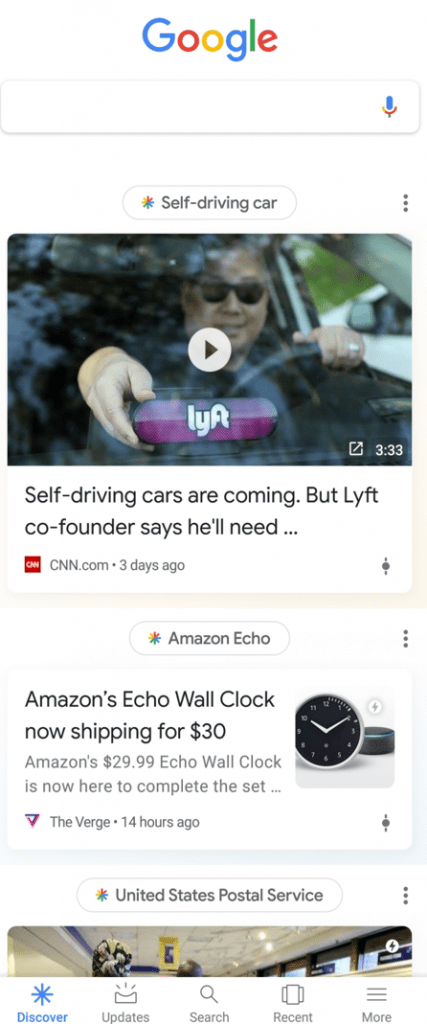The future of search goes beyond blue links on a search results page. In 2019, more results will come in the form of voice response, images, or before the searcher even enters a query.
Web search is evolving. Consumers access the internet across an increasing number of devices. And search engines such as Google can process images and videos more reliably than before, allowing them to appear in search results.
New device inputs and search outputs mean that a searcher won’t necessarily receive a set of blue text links that traditional search engine optimization has focused on. Tomorrow’s search optimization requires new tools and strategies.
No Query Needed
Google Discover — formerly Google Feed and Google Now — aims to deliver what searchers are looking for before they even search for it. Intended to mimic social media feeds, Discover content is fed by the vast data that Google has on most people. It displays the information, images, and videos that it thinks someone would want to consume based on her search and other Google activity.

Above each Discover card is a search phrase that Google has algorithmically customized to the user — “Self-driving car” in this example.
Google pushed the Discover experience to the mobile search home page this fall. Above each Discover “card” lies a search phrase that Google has algorithmically customized to the user.
To optimize for Discover, an ecommerce company should tap into its content marketing strategy. Use evergreen informational content such as guides and how-tos, as well as fresh, high-quality content.
Content that does well in social media should also succeed in Discover, assuming it’s created with SEO in mind: hosted on the ecommerce site, easily crawled by search bots, with strong contextual relevance and internal linking.
No Results Page
Optimizing for voice search depends on the device being used. Google reports that 20 percent of mobile searches are via voice. It’s no longer just a trend. It’s a reality to plan for.
Screenless devices such as Google Home and Amazon Echo produce just one search result. If it doesn’t win that one result, your site won’t receive visibility in voice search.
If the device is a smartphone, tablet, or computer, a voice search on Google will still yield a results page, even though the answer may still be spoken. If the result is acceptable, the searcher may move on without viewing the rest of the results.
No Textual Results
Image search has existed for years. It is finally gaining traction as Google improves its ability to identify elements within images.
Google Lens — which recently debuted on iOS and was already live on Android — is an indicator of Google’s image recognition capability. Understanding text within images is pretty good now, especially on photos of products and locations.
Google Lens identifies the shoe at the top and shows where to buy it and similar styles.
For ecommerce, image search and shopping are a valuable combination. When you can take a picture of the shoes someone on the train is wearing and have Google Lens tell you what style it is and where to buy it, it taps into the natural human weakness for instant gratification.
Suddenly, optimizing for image search is not just a bonus or something to avoid for fear that other sites will steal your images. It’s a necessity if you want to capture those instant sales.
Desktop Search
Traditional desktop search is changing, too. Search results produce more ads, images, and videos. The local three pack is nearly ubiquitous.
Traditional desktop search is changing, too. Search results produce more ads, images, and videos. Click image to enlarge.
All of this visually stimulating content pushes traditional text results down the page. Ranking number one is no longer enough. A visible ecommerce search footprint requires a multi-faceted strategy. Where it makes sense, use ads, images, and videos in addition to traditional text.